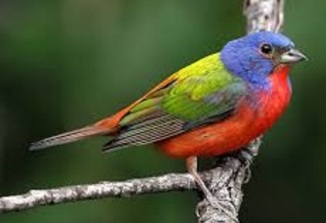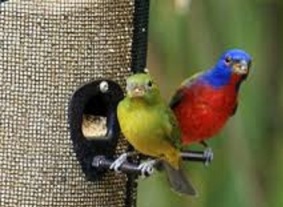


“Each species is a masterpiece, a creation assembled with extreme care and genius.” — E.O. Wilson
As we mark the 50th anniversary of Earth Day, I wanted to present something intriguing. The one thing that leapt out at me was something that’s been nagging me lately and I’ve been meaning to look into it.
So, here it is. I’ll drag you along as I explore these incredibly colorful birds. These species have survived despite the onslaught of humans. They are similar yet different, if that makes any sense. You’ll see what I mean.
My question is, Why? Why has nature given these birds such similarly distinctive patterns?
Thousands of their ancestors suffered being trapped and moved thousands of miles, to live out their lives in cages. Today, some wild birds still face being sold for pets, but there is hope that wild populations can continue to exist.
Painted Bunting
These are perhaps the closest thing we have to parrots in the U.S. (though there are some introduced, non-native parrots.)

Males are spectacular with a blue head, red on the breast and back, and bright yellow-green around the shoulders and upper back. Females are green-yellow.

Native to North America, they breed in the southeastern and south-central U.S. and winter in Mexico and Central America. They favor scrubby and coastal habitat. With their thick bills, it’s easy to see that they’re seed eaters.
Painted buntings have always been prized for their beautiful feathers and they’ve long been captured to be sold as caged birds. In the mid-1800s, John James Audubon reported that thousands were being caught and shipped to Europe.

Today, birds are still illegally caught and sold in Mexico, Central America and the Caribbean. I cannot imagine these wild birds living very long in a cage.

Their overall population is said to be stable, though like most birds, they suffer from habitat loss. The eastern population favors swampy thickets and woodland edges that often are destroyed by human development.
Gouldian Finch
Also known as the Lady Gouldian finch or rainbow finch, these are native to the grasslands of Australia. Male plumage can vary in the color pattern. In the wild, males usually have black faces, but can have yellow or red variations.

Captive birds for the pet trade are selectively bred for red faces. The males feature turquoise around the face, green on the back, purple on the chest and yellow on the belly. Females have a similar color pattern, though not as bright.
About the time that painted buntings began to be trapped and exported from America to Europe for pets, Gouldian finches also were similarly being extracted from the wild.

By the 1980s, trapping had reduced the wild population to only about 2,500. In 1992 they were declared endangered in the wild by the Union of Conservation of Nature and Natural Resources.
Today, it’s illegal to export them from Australia, but they continue to face challenges to increasing their wild numbers. 
Gouldian finches may be as challenging to save in the wild as our endangered orcas – the Southern Resident Killer Whales – native to Puget Sound. Both species have incredibly narrow, specific food preferences.
Gouldian finches eat seeds of certain native grasses and conservation biologists discovered that they nest only in specific types of deep hollow branches of only two types of eucalyptus trees. Researchers are hoping that by installing specially constructed nest boxes in the wild, they can help boost finch numbers.

Other factors that impact Gouldian finches are their bright colors, which make them easy targets for predators, diseases and wild fires. They are still popular as pets, though all sold are captive bred. They do not like to be handled and don’t do well with a lot of human interaction, compared to other finches kept as pets. Their average lifespan is six to eight years.
Rainbow Lorikeet
This brilliantly colored bird is also native to Australia. A blue head, red beak, orange and yellow breast, blue belly, and green wings and back make this species distinctive among parrots. 
They grow to about a foot long from beak to tail.
In the wild, their preferred habitat includes woodlands, and lowland forests, and rainforest. Like the Gouldian finch, lorikeets prefer to nest in hollow limbs and holes in eucalyptus trees.

But they have been moving into more urban areas and easily adapt. Their diet includes fruit, nectar and pollen, and they will visit bird feeders and eat various seeds. They have even become pests in some areas, such as orchards and farmlands, and in New Zealand, where they were illegally introduced.

Needless to say, this species not threatened or endangered. In fact, they can out compete other native species of parrot and cockatoo for nesting holes.

Rainbow lorikeets are very popular as pets, with captive bred birds available worldwide. They can live up to 30 years.
In conclusion
I have not answered my question. Why? Why are there such brightly colored birds? It’s no camouflage against predators. I have noted that most such colorful birds live in more tropical environments. Does climate have something to do with coloration? More questions needing more research.
Mother Nature has given us many mysteries, but one thing we do know, she has it all worked out. Everything is the way it is for a reason. Everything is linked to something else. We are running out of time to preserve the links.
“When we try to pick out anything by itself, we find it hitched to everything else in the universe.” — John Muir
*Not my photos
Well presented, but who knows why? Thanks for your Happy Earth Day gift to us all.
LikeLike
Thanks, Annie. Have a safe and happy day.
LikeLike
Beautiful photos and interesting comment. Thanks!
LikeLike
Thank you! I realize I didn’t go too deeply into it, but it is fascinating.
LikeLike